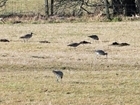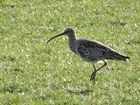Blogs
-

-

in:
GWCT News Blog
under:
Waders
, Woodcock
The question of how many woodcock might spend their winters in the UK may seem straightforward but is actually extremely difficult to answer. The fundamental reason is the secrecy of these birds, so that simple counting of those we may see in winter is not an accurate reflection of the number that might be present, camouflaged in the woods and active at night.
-

in:
GWCT News Blog
under:
Waders
, Woodcock
One of the most important things to understand about woodcock in the UK is that there are two distinct groups which behave in different ways and are experiencing different fates - resident and migratory.
-

in:
GWCT News Blog
under:
Waders
, Woodcock
Woodcock are found in woodland habitats right across northern Europe and Asia, ranging from Britain in the West to Japan in the East.
-

in:
GWCT News Blog
under:
GWCT Scotland
, GWCT in the media
, Letters
, Waders
The plight of waders breeding in the UK is well known. All of our familiar species are in serious decline and we hear frequent warnings about local extinctions for some of them. Well known causes of decline are a loss of quality habitat due to changes in land use and intensified agricultural practices, and we are seeing increased losses of wader nests to a variety of predators.
-

in:
GWCT News Blog
under:
Waders
You may be aware that we're currently raising funds to purchase more essential trail cameras to help us understand what's driving the decline in ground-nesting bird populations. Trail cameras show us exactly what is predating nests and provide vital evidence we can share with policymakers, landowners, conservation bodies, and the government. You can see images from some of the footage we've been able to capture with trail cameras here.
-

-

in:
GWCT News Blog
under:
Waders
, Woodcock
Every ten years the BTO and GWCT collaborate on a survey to estimate the UK's breeding woodcock population. Watch this short video by the GWCT's Olly Dean featuring our Head of Wetlands Research Chris Heward demonstrating what's involved.
-

in:
GWCT News Blog
under:
Waders
This is the second year of my PhD study of nest and chick survival of curlew in the New Forest. This season GWCT Head of Predation Control Studies Mike Short and I found a total of 28 curlew nests (approximately half of the pairs in the New Forest), compared with 23 last year.
-

in:
GWCT News Blog
under:
Waders
The GWCT is assisting with an exciting new project initiated by the Norfolk Estate, Sussex, to establish a breeding curlew population on the South Downs. The project involves a technique called headstarting, whereby eggs are taken from the wild, incubated artificially, and then chicks are reared to fledging age in enclosures before release into the wild.
Get the Latest News & Advice
Join over 100,000 subscribers and stay updated on our latest advice, research, news and offers.
*You may change your mind any time. For more information, see our Privacy Policy.